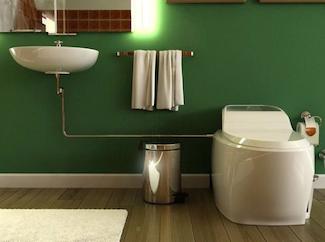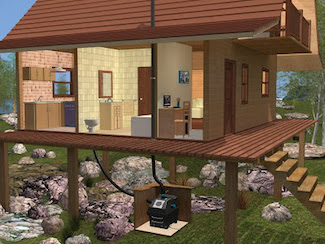Composting Toilets
The modern flush toilet, and the entire infrastructure that makes them possible, from indoor plumbing to sewers and septic systems to wastewater treatment systems, make our lives cleaner and more convenient than most of us could probably imagine. But they come at a cost: enormous water use. Composting toilets eliminate the need for water altogetherEven the most water-efficient toilets on the market today use at least a gallon or so of water per flush. Older, less efficient models can use much more, up to 3 or more gallons per flush. No one will deny the quality of life boost that the "flush it and forget it" convenience that the water flush toilet gives us.
Toilet Alternatives: Composting Toilets
There are a growing number of water conservation advocates who claim that the amount of clean water necessary to flush all of our toilets is an unwise use of a precious and dwindling natural resource. Depending on how much water the toilet uses per flush, anywhere from 2,000 to 12,000+ gallons of water per year is flushed down the drain of the average U.S. toilet.
Many homeowners who are off the grid, or are simply interested in reducing their environmental impacts and want to use as little water as possible, are investing in waterless, composting toilet systems.
Are composting toilets a viable alternative to the traditional, familiar water-flush toilet? That's a personal question; in order to help you answer the question for your own personal situation, let's look at what composting toilets are, how they work.
Composting Toilets 101: The Basics
The best to avoid wastewater treatment problems is to avoid waste altogether. Composting toilets eliminate wastewater by not using water at all. Instead of mixing clean potable water with human waste, composting toilet systems use the natural processes of biological decomposition. Simply put: they convert human waste into carbon dioxide and water vapor over a period of time. And while you might think this process of decomposition, happening in or very near to your home, would be a stinking, disgusting mess, that's not the case. Todays' modern composting toilet systems work very efficiently. They destroy the pathogens in the waste, significantly reduce the physical volume of the solid wastes, and produce an end-result of nutrient-rich compost which can be used to fertilize non-food plants. A full-sized composting toilet in the home will produce only a few buckets of compost annually. The composting process eliminates the majority of the solid waste by converting it into carbon dioxide and water vapor, which is vented harmlessly through a vent exhaust.Types of Composting Toilets
There are many different types of composting toilets,made by a variety of pioneering companies. Some rustic, adventurous types make do with a bucket and sawdust with a toilet seat on top or a good old-fashioned outhouse. But for those of us accustomed to the convenience of flush toilets, we require something a little more sophisticated. Generally speaking, the larger composting toilet systems tend to be more reliable and hassle-free, and provide the higher levels of customer satisfaction. Of course, these systems are also more expensive.
Self-Contained Composting Toilets
A self-contained composting toilet (pictured above) is exactly what it sounds like. Self-contained composting units do all of their work right in the unit itself. Larger than a conventional toilet, these systems are vented to the outside. Many models use fans to aid aeration and ventilation, and some also contain a heating element to ensure proper composting temperatures and aid in the evaporation of moisture.
Users of self-contained composting toilets usually add small amounts of a carbon-based material (sawdust, peat moss,coconut husk, etc.) to the chamber. These materials act to add air pockets to faciliate better aerobic composting, absorb moisture, and provide an odor barrier.
Self-contained composting toilets are a good choice for those with smaller homes, or homes that have no access to the toilet from below. They're also more affordable than other types of systems.
Central Composting Toilet Systems
Central composting toilets, also known as underfloor or remote systems, are more complex than self-contained models. These systems consist of a toilet stool (which looks much like a conventional toilet) in the bathroom. The toilet stool collects the waste, which drains either waterlessly or with a very small flush of water into a large composter located below in a basement or even an exterior location. Some models use a 'vacuum-flush' to move waste horizontally or upwards with a small amount of water (approx. 17 ounces.) The larger compost chamber is beneficial for high-use locations, year-round use, or for collecting waste from several indoor toilets.
For many, separating the waste and locating it in a remote location for composting is more desirable than having the process take place right at the toilet location. The remote system, by moving waste to another part of the house or to the outside, removes any chance of offensive odors, though it should be mentioned that any properly-functioning compost toilet will have very little if any odor in the first place.
All forms of composting toilets have access drawers, or finishing drawers, where the dry, odorless compost is removed. Again, this finished compost is perfect for fertilizing any non-food plants.
Advantages and Disadvantages of Compost Toilets
The biggest advantage of composting toilets is the drastic reduction in the home's water usage. For true off-grid homes without running water, they often present the only realistic option, though more people are installing them even in areas with access to water and plumbing out of a concern for water conservation. In remote areas, composting toilets eliminate the need for septic systems.
The major disadvantage of composting toilets is their cost. To put it bluntly, a good composting toilet system is going to be expensive. Typical models range from $3000 to $5000. More complex central composting systems can be twice that. But as mentioned, they may be cheaper than building an in-ground septic system.
If you are considering a composting toilet system, it's important to do your homework. Many areas have building codes (or mortgage lenders) that require a fully-installed inground septic system and disposal field even if you never plan on using them with your composting toilet.
There's also a strong psychological element to deciding whether a composting toilet is right for you. As mentioned at the beginning of this article, we have all been conditioned to flush everything away to let somebody else care for our wastewater. To some, the thought of composting human waste onsite, however odorless and effortless that process may be, is too radical to overcome. And that's perfectly understandable. But as composting toilets slowly gain popularity, and earn a reputation for being not so different than flush toilets after all, their popularity will spread. As our planets' climate changes, many areas will have dwindling access to clean water. It will become harder, and much more expensive, to justify flushing it down the drain.
Learn more aboutEnvirolet,a leading manufacturer of a full line of composting toilet systems HERE.
comments powered by Disqus




























































































































































































